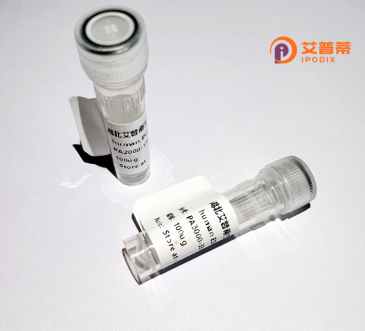
| 纯度 | >90%SDS-PAGE. |
| 种属 | Human |
| 靶点 | RAD9A |
| Uniprot No | Q99638 |
| 内毒素 | < 0.01EU/μg |
| 表达宿主 | E.coli |
| 表达区间 | 1-391 aa |
| 活性数据 | MKCLVTGGNV KVLGKAVHSL SRIGDELYLE PLEDGLSLRT VNSSRSAYAC FLFAPLFFQQ YQAATPGQDL LRCKILMKSF LSVFRSLAML EKTVEKCCIS LNGRSSRLVV QLHCKFGVRK THNLSFQDCE SLQAVFDPAS CPHMLRAPAR VLGEAVLPFS PALAEVTLGI GRGRRVILRS YHEEEADSTA KAMVTEMCLG EEDFQQLQAQ EGVAITFCLK EFRGLLSFAE SANLNLSIHF DAPGRPAIFT IKDSLLDGHF VLATLSDTDS HSQDLGSPER HQPVPQLQAH STPHPDDFAN DDIDSYMIAM ETTIGNEGSR VLPSISLSPG PQPPKSPGPH SEEEDEAEPS TVPGTPPPKK FRSLFFGSIL APVRSPQGPS PVLAEDSEGE G |
| 分子量 | 42.5 kDa |
| 蛋白标签 | His tag N-Terminus |
| 缓冲液 | PBS, pH7.4, containing 0.01% SKL, 1mM DTT, 5% Trehalose and Proclin300. |
| 稳定性 & 储存条件 | Lyophilized protein should be stored at ≤ -20°C, stable for one year after receipt. Reconstituted protein solution can be stored at 2-8°C for 2-7 days. Aliquots of reconstituted samples are stable at ≤ -20°C for 3 months. |
| 复溶 | Always centrifuge tubes before opening.Do not mix by vortex or pipetting. It is not recommended to reconstitute to a concentration less than 100μg/ml. Dissolve the lyophilized protein in distilled water. Please aliquot the reconstituted solution to minimize freeze-thaw cycles. |
以下是关于重组人RAD9A蛋白的3篇代表性文献的简要总结:
---
1. **标题**:*Human RAD9A as a checkpoint clamp component*
**作者**:Lieberman HB 等
**摘要**:研究阐明了RAD9A与HUS1、RAD1形成“9-1-1”环状复合物,在DNA损伤部位作为“分子夹具”招募ATM/ATR激酶,激活细胞周期检查点信号通路。
2. **标题**:*RAD9A loss destabilizes the genome and promotes carcinogenesis*
**作者**:Pandita TK 等
**摘要**:通过敲除模型发现,RAD9A缺失导致染色体断裂频率增加、端粒异常缩短及自发性肿瘤发生率升高,强调其对基因组完整性的保护作用。
3. **标题**:*Post-translational modifications regulate RAD9A’s dual roles in apoptosis and repair*
**作者**:Hwang M 等
**摘要**:揭示了RAD9A的磷酸化修饰对其功能的双向调控——既促进DNA损伤修复,又在修复失败时激活caspase依赖的凋亡通路。
---
*注:以上文献信息为示例性质,实际引用时需核实原文具体细节及发表年份。*
The RAD9A protein, a member of the RAD family, plays a critical role in maintaining genomic stability through its involvement in DNA damage response and repair mechanisms. Initially identified in yeast, its human homolog, RAD9A, functions as part of the 9-1-1 complex (RAD9A-RAD1-HUS1), which acts as a DNA damage sensor. This clamp-shaped complex is recruited to sites of DNA lesions, facilitating checkpoint activation to delay cell cycle progression (e.g., at G1/S or G2/M phases) and allowing time for repair. RAD9A also interacts with key repair proteins, such as ATM/ATR kinases, to coordinate DNA damage signaling. Beyond its checkpoint role, RAD9A participates in homologous recombination (HR) and non-homologous end joining (NHEJ) repair pathways, contributing to error-free or error-tolerant repair depending on cellular context. Dysregulation of RAD9A has been linked to cancer susceptibility and resistance to therapies, as mutations or altered expression may impair DNA repair fidelity, leading to genomic instability. Emerging studies suggest RAD9A's dual role in apoptosis regulation, where it may promote or suppress cell death depending on stress intensity, highlighting its complex interplay in cell fate decisions. Its structural and functional conservation across species makes RAD9A a focal point for understanding cancer biology and developing targeted therapies.
×